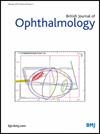静脉注射甲基强的松龙对甲状腺眼病患者血清抗体水平的影响
IF 3.5
2区 医学
Q1 OPHTHALMOLOGY
引用次数: 0
摘要
背景/目的 我们评估了静脉甲基强的松龙(IVMP)治疗后自身抗体的纵向变化,将其与未经治疗的患者进行了比较,并确定了治疗反应的预后因素。方法 在这项单中心、回顾性、观察性研究中,共招募了163名被诊断为中重度甲状腺眼病的患者,并对他们进行了为期12个月的随访。根据是否使用 IVMP,我们将患者分为治疗组和对照组。根据 IVMP 对 TSH 受体(TSH Rc)抗体水平的影响,我们将患者分为抗体下降组和抗体未下降组。我们使用广义估计方程评估了时间、组别和交互作用与 12 个月内纵向自身抗体滴度的关系。我们使用多变量逻辑回归法研究了对 IVMP 反应不佳的预后因素。结果 在 IVMP 组中,TSH Rc 抗体(Ab)滴度在 6 个月内迅速下降,然后在 12 个月前缓慢下降,在 12 个月时与对照组相似。这表明,IVMP 组和对照组的下降模式随时间推移存在差异(组与时间的交互作用 p=0.029)。总胆固醇(OR 1.0217 (95% CI 1.0068 to 1.0370),p=0.0043)是类固醇反应的重要预后因素。区分 Ab 下降和 Ab 未下降的临界总胆固醇值为 186 mg/dL。结论 与未治疗组相比,IVMP 可明显降低治疗后 3 个月的 TSH Rc Ab 水平,但 12 个月后各组间无明显差异。总胆固醇水平高的患者对 IVMP 的反应一般较差。如有合理要求,可提供相关数据。如向作者索取,可获得本研究过程中生成和/或检查的数据集。本文章由计算机程序翻译,如有差异,请以英文原文为准。
Effect of intravenous methylprednisolone on serum antibody levels in thyroid eye disease
Background/aims We evaluated longitudinal autoantibody changes after intravenous methylprednisolone (IVMP), compared them with those in untreated patients and identified prognostic factors for treatment response. Methods In this single-centre, retrospective, observational study, a total of 163 individuals diagnosed with moderate-to-severe thyroid eye disease were enrolled and followed for 12 months. Depending on whether IVMP was administered, we divided the patients into treatment and control groups. Based on the effect of IVMP on TSH receptor (TSH Rc) antibody level, we divided the patients into Ab declined and Ab not declined groups. We evaluated the time, group and interaction associations with the longitudinal autoantibody titres over 12 months using generalised estimating equations. Using multivariable logistic regression, we investigated the prognostic factors for a poor response to IVMP. Results In the IVMP group, the TSH Rc antibody (Ab) titre decreased rapidly for 6 months and then decreased slowly until 12 months, becoming similar to the control group at 12 months. This suggests a difference in the decreasing pattern over time between the IVMP and control groups (group and time interaction p=0.029). Total cholesterol (OR 1.0217 (95% CI 1.0068 to 1.0370), p=0.0043) was a significant prognostic factor for the steroid response. The threshold total cholesterol value to distinguish between Ab declined and Ab not declined was 186 mg/dL. Conclusion IVMP significantly decreased the TSH Rc Ab level for the 3 months after treatment, compared with the no-treatment group, but the groups did not differ significantly after 12 months. Patients with high total cholesterol levels generally showed a poor response to IVMP. Data are available on reasonable request. The datasets produced during and/or examined in the course of our present study can be obtained if requested to the author.
求助全文
通过发布文献求助,成功后即可免费获取论文全文。
去求助
来源期刊
CiteScore
10.30
自引率
2.40%
发文量
213
审稿时长
3-6 weeks
期刊介绍:
The British Journal of Ophthalmology (BJO) is an international peer-reviewed journal for ophthalmologists and visual science specialists. BJO publishes clinical investigations, clinical observations, and clinically relevant laboratory investigations related to ophthalmology. It also provides major reviews and also publishes manuscripts covering regional issues in a global context.

 求助内容:
求助内容: 应助结果提醒方式:
应助结果提醒方式:


